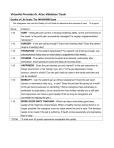Quality of Life Scale
You Can Use the Following Pet Quality of Life Scale to Objectively Record Your Pet’s Status
Download your customizable .odt copy of the Quality of Life Scale.
Download .odt Doc Springer’s Quality of Life Self- Coaching Questionnaire.
Download pdf Doc Springer‘s Quality of Life Self-Coaching Questionnaire.
Dr Alice Villalobos, a renowned veterinary oncologist, published a scoring system for life quality called the HHHHHMM Scale. The letters stand for: Hurt, Hunger, Hydration, Hygiene, Happiness, Mobility and More Good Days than Bad. Having a semi-objective scale, and having notes about your wishes and feelings before your pet became ill, can help you clear your heart and your mind when your pet is ill and you are confused or worried you may not be thinking clearly enough to make a proper decision on your pet’s behalf.
| Quality of Life Scale: The HHHHHMM Scale | |
| Pet caregivers can use this Quality of Life Scale to determine the success of care. Score patients using a scale of 1 to 10. |
|
| Score | Criterion |
| 1-10 | HURT – Adequate pain control, including breathing ability, is first and foremost on the scale. Is the pet’s pain successfully managed? Is oxygen supplementation necessary? |
| 1-10 | HUNGER – Is the pet eating enough? Does hand feeding help? Does the patient require a feeding tube? |
| 1-10 | HYDRATION – Is the patient dehydrated? For patients not drinking enough, use subcutaneous fluids once or twice daily to supplement fluid intake. |
| 1-10 | HYGIENE – The patient should be brushed and cleaned, particularly after elimination. Avoid pressure sores and keep all wounds clean. |
| 1-10 | HAPPINESS – Does the pet express joy and interest? Is the pet responsive to things around him or her (family, toys, etc.)? Is the pet depressed, lonely, anxious, bored or afraid? Can the pet’s bed be close to the family activities and not be isolated? |
| 1-10 | MOBILITY – Can the patient get up without assistance? Does the pet need human or mechanical help (e.g., a cart)? Does the pet feel like going for a walk? Is the pet having seizures or stumbling? (Some caregivers feel euthanasia is preferable to amputation, yet an animal who has limited mobility but is still alert and responsive can have a good quality of life as long as caregivers are committed to helping the pet.) |
| 1-10 | MORE GOOD DAYS THAN BAD – When bad days outnumber good days, quality of life might be compromised. When a healthy human-animal bond is no longer possible, the caregiver must be made aware the end is near. The decision needs to be made if the pet is suffering. If death comes peacefully and painlessly, that is okay. |
| *TOTAL | *A total over 35 points represents acceptable life quality |
Adapted by Villalobos, A.E., Quality of Life Scale Helps Make Final Call, VPN, 09/2004, for Canine and Feline Geriatric Oncology Honoring the Human-Animal Bond, by Blackwell Publishing, Table 10.1, released 2006.
Dr Truli is available for a house call consultation to meet your pet and determine the quality of life with you. This is an important step in the management of your pet’s aging or in disease management. While these charts may help you, quality of life is a serious consideration and a perfectly legitimate topic for a house call consultation. Call or text (813) 714-7863 for an appointment.
Dr. Sandra Truli Springer, VMD, CVA, CVFT, CVTP, CVCH, CTCVMP
“Truli holistic veterinary services” | Care provided in your home!
Greater Tampa Bay, Florida, USA
Call toll-free 1 (877) DR TRULI | (877) 378-7854
Comments are closed.




Howdy
It is my first time here. I just wanted to say hi!